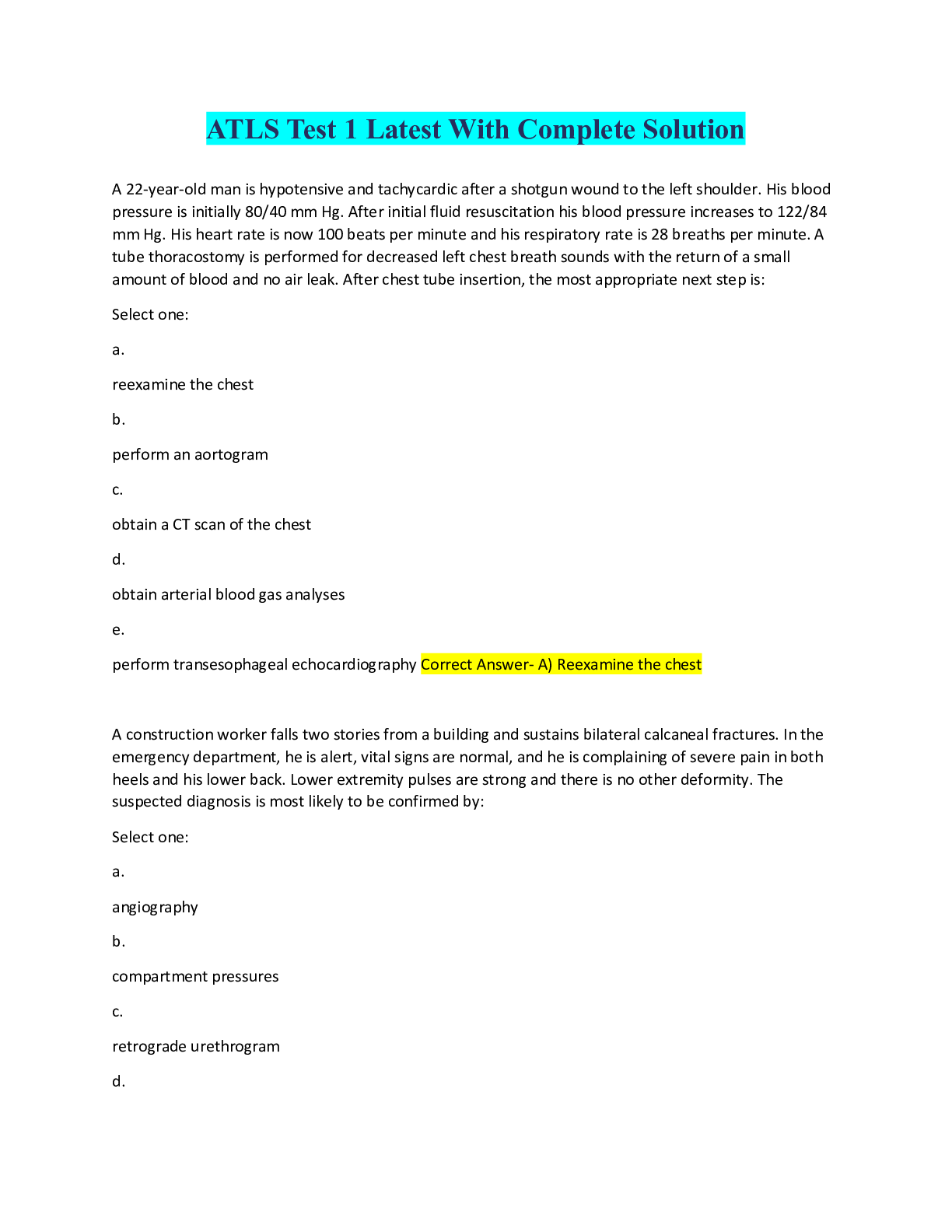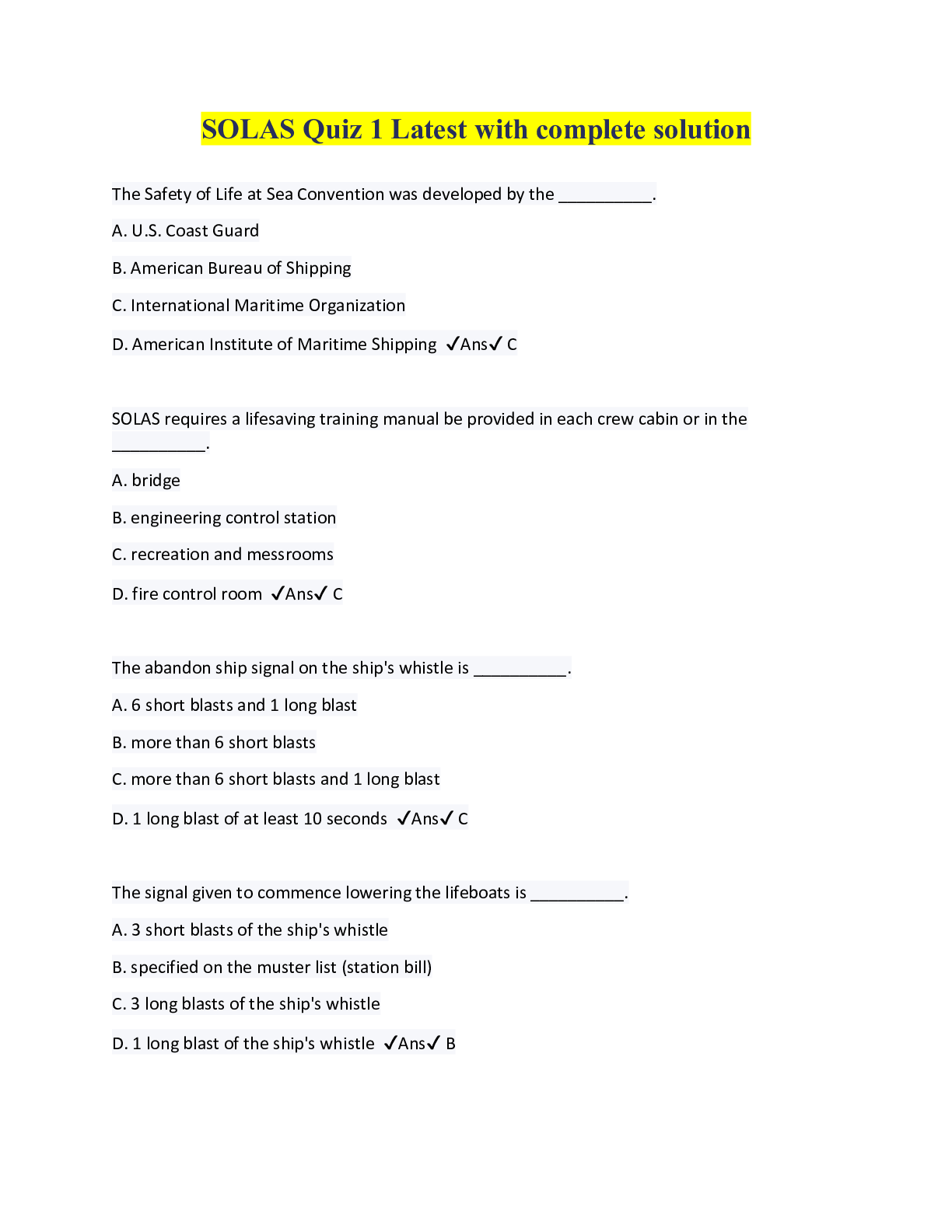*NURSING > QUESTIONS & ANSWERS > ATLS Test 1 Latest With Complete Solution (All)
ATLS Test 1 Latest With Complete Solution
Document Content and Description Below
ATLS Test 1 Latest With Complete Solution A 22-year-old man is hypotensive and tachycardic after a shotgun wound to the left shoulder. His blood pressure is initially 80/40 mm Hg. After initial flui... d resuscitation his blood pressure increases to 122/84 mm Hg. His heart rate is now 100 beats per minute and his respiratory rate is 28 breaths per minute. A tube thoracostomy is performed for decreased left chest breath sounds with the return of a small amount of blood and no air leak. After chest tube insertion, the most appropriate next step is: Select one: a. reexamine the chest b. perform an aortogram c. obtain a CT scan of the chest d. obtain arterial blood gas analyses e. perform transesophageal echocardiography Correct Answer- A) Reexamine the chest A construction worker falls two stories from a building and sustains bilateral calcaneal fractures. In the emergency department, he is alert, vital signs are normal, and he is complaining of severe pain in both heels and his lower back. Lower extremity pulses are strong and there is no other deformity. The suspected diagnosis is most likely to be confirmed by: Select one: a. angiography b. compartment pressures c. retrograde urethrogram d.Doppler ultrasound studies e. complete spine x-ray series Correct Answer- e) Complete spine x-ray series Which of the following is true regarding the initial resuscitation of a trauma patient? Select one: a. A patient that presents with a torso gunshot wound and is hypotensive should receive crystalloid fluid resuscitation until the blood pressure is normal b. Evidence of improved perfusion after fluid resuscitation could include improvement in Glasgow coma scale score on reevaluation c. Massive transfusion is defined as transfusion of more than >10 of packed red blood cells and plasma in 24 hours d. When tranexamic acid is administered by pre-hospital providers a second dose is required within 24 hours e. Fluid resuscitation is far more important than bleeding control in trauma patients Correct Answer- b. Evidence of improved perfusion after fluid resuscitation could include improvement in Glasgow coma scale score on reevaluation In managing a patient with a severe traumatic brain injury, the most important initial step is to: Select one: a. Secure the airway b. obtain a c-spine film c.support the circulation d. control scalp hemorrhage e. determine the GCS score Feedback Your answer is corr Correct Answer- a. Secure the airway A previously healthy, 70-kg (154-pound) man suffers an estimated acute blood loss of 2 liters. Which one of the following statements applies to this patient? Select one: a. His pulse pressure will be widened. b. His urinary output will be at the lower limits of normal. c. He will have tachycardia, but no change in his systolic blood pressure. d. An ABG would demonstrate a base deficit between -6 and -10 mEq/L e. His systolic blood pressure will be maintained with an elevated diastolic pressure. Correct Answer- d. An ABG would demonstrate a base deficit between -6 and -10 mEq/L The physiologic hypervolemia of pregnancy has clinical significance in the management of the severely injured, gravid woman by: Select one: a. reducing the need for blood transfusionb. resulting in an elevated hematocrit c. complicating the management of closed head injury d. reducing the volume of crystalloid required for resuscitation e. increasing the volume of blood loss to produce maternal hypotension Correct Answer- e. increasing the volume of blood loss to produce maternal hypotension The best assessment of fluid resuscitation of the adult burn patient is: Select one: a. Urine output of 0.5 mL/kg/hr b. normalization of blood pressure c. normalization of the heart rate d. measuring a normal central venous pressure e. providing 4 mL/kg/percent body burn/24 hours of crystalloid fluid Correct Answer- a. Urine output of 0.5 mL/kg/hr The diagnosis of shock must include: Select one: a. hypoxemia b.acidosis c. hypotension d. increased vascular resistance e. evidence of inadequate organ perfusion Correct Answer- e. evidence of inadequate organ perfusion A 7-year-old boy is brought to the emergency department by his parents several minutes after he fell through a window. He is bleeding profusely from a 6-cm wound of his medial right thigh. Immediate management of the wound should consist of: Select one: a. application of a tourniquet b. direct pressure on the wound c. packing the wound with gauze d. direct pressure on the femoral artery at the groin e. debridement of devitalized tissue Correct Answer- b. direct pressure on the wound For the patient with severe traumatic brain injury, profound hypocarbia should be avoided to prevent: Select one: a. respiratory acidosisb. metabolic acidosis c. cerebral vasoconstriction with diminished perfusion d. neurogenic pulmonary edema e. shift of the oxyhemoglobin dissociation curve Correct Answer- c. cerebral vasoconstriction with diminished perfusion After being involved in a motor vehicle crash, a 25-year-old man is brought to a hospital that has surgery capabilities available.. Computed tomography of the chest and abdomen shows an aortic injury and splenic laceration with free abdominal fluid. His blood pressure falls to 70 mm Hg after CT. The next step is: Select one: a. obtain contrast angiography b. transfer to a higher level trauma center c. perform an exploratory laparotomy d. infuse additional crystalloid fluids e. Obtain transesophageal echocardiography Correct Answer- c. perform an exploratory laparotomy Which one of the following statements regarding abdominal trauma in the pregnant patient is TRUE? Select one: a.The fetus is in jeopardy only with major maternal abdominal trauma. b. Leakage of amniotic fluid is an indication for hospital admission. c. Indications for peritoneal lavage are different from those in the nonpregnant patient. d. With penetrating trauma, injury to the mother's abdominal hollow viscus is more common in late than in early pregnancy. e. The secondary survey follows a different pattern from that of the nonpregnant patient. Correct Answerb. Leakage of amniotic fluid is an indication for hospital admission. The first maneuver to improve oxygenation after chest injury is to: Select one: a. intubate the patient b. assess arterial blood gases c. administer supplemental oxygen d. ascertain the need for a chest tube e. obtain a chest x-ray Correct Answer- c. administer supplemental oxygen A 25-year-old man, injured in a motor vehicular crash, is admitted to the emergency department. His pupils react sluggishly and his eyes open to pressure. He does not follow commands, but he does moanperiodically. His right arm is deformed and does not respond to pressure; however, his left hand reaches purposefully toward the stimulus. Both legs are stiffly extended. His GCS score is: Select one: a: 2 b: 4 c: 6 d: 9 e: 12 Correct Answer- d: 9 Which one of the following findings in an adult is most likely to require immediate management during the primary survey? Select one: a. distended abdomen b. Glasgow Coma Scale score of 11 c. temperature of 36.5°C (97.8°F) d. deformity of the right thigh e. respiratory rate of 40 breaths per minute Correct Answer- e. respiratory rate of 40 breaths per minute A 20-year-old woman that is 32 weeks gestation , is stabbed in the upper right chest. In the emergency department, her blood pressure is 80/60 mm Hg. She is gasping for breath, extremely anxious, and yelling for help. Breath sounds are diminished in the right chest. The most appropriate first step is to: Select one: a. perform tracheal intubationb. insert an oropharyngeal airway c. perform needle or finger decompression of the right chest d. manually displace the gravid uterus to the left side of the abdomen e. initiate 2, large-caliber peripheral IV lines and crystalloid infusion Correct Answer- c. perform needle or finger decompression of the right chest An important, immediate step in the management of an open pneumothorax is: Select one: a. endotracheal intubation b. operation to close the wound c. placing a chest tube through the chest wound d. placement of an occlusive dressing over the wound secured on three sides e. initiation of 2, large-caliber IVs and infusing crystalloid solution Correct Answer- d. placement of an occlusive dressing over the wound secured on three sides Which of the following is a contraindication for tetanus toxoid administration? Select one: a. history of neurological reaction or severe hypersensitivity to the product b.Local side effects c. muscular spasms d. pregnancy e. all of the above Correct Answer- a. history of neurological reaction or severe hypersensitivity to the product A 56-year-old man is thrown violently against the steering wheel of his truck during a motor vehicle crash. On arrival to the emergency department he is diaphoretic and complaining of chest pain. His blood pressure is 60/40 mm Hg and his respiratory rate is 40 breaths per minute. Which of the following best differentiates cardiac tamponade from tension pneumothorax as the cause of his hypotension? Select one: a. tachycardia b. pulse volume c. breath sounds d. pulse pressure e. jugular venous pressure Correct Answer- c. breath sounds Bronchial intubation of the right or left mainstem bronchus can easily occur during infant endotracheal intubation because: Select one: a.The trachea is relatively short. b. The distance from the lips to the larynx is relatively short. c. The use of cuffed endotracheal tubes eliminates this issue. d. The mainstem bronchi are less angulated in their relation to the trachea. e. So little friction exists between the endotracheal tube and the wall of the trachea. Correct Answer- a. The trachea is relatively short. A 23-year-old man sustains 4 stab wounds to the upper right chest during an altercation and is brought by ambulance to a hospital that has full surgical capabilities. His wounds are all above the nipple. He is endotracheally intubated, closed tube thoracostomy is performed, fluid resuscitation is initiated through 2 large-caliber IVs. FAST exam does not reveal intraabdominal injuries. His blood pressure now is 60/0 mm Hg, heart rate is 160 beats per minute, and respiratory rate is 14 breaths per minute (ventilated with 100% O2). 1500 mL of blood has drained from the right chest. The most appropriate next step in managing this patient is to Select one: a. perform diagnostic peritoneal lavage b. obtain a CT of the chest c. perform an angiography d. urgently transfer the patient to the operating room [Show More]
Last updated: 2 years ago
Preview 1 out of 22 pages

Buy this document to get the full access instantly
Instant Download Access after purchase
Buy NowInstant download
We Accept:

Also available in bundle (1)

ATLS FULL TESTS WITH COMPLETE SOLUTION PACK
Aconstitute of exam questions with answers, graded A+
By bundleHub Solution guider 2 years ago
$16
4
Reviews( 0 )
$8.00
Can't find what you want? Try our AI powered Search
Document information
Connected school, study & course
About the document
Uploaded On
Sep 02, 2022
Number of pages
22
Written in
Seller

Reviews Received
Additional information
This document has been written for:
Uploaded
Sep 02, 2022
Downloads
0
Views
137















.png)




